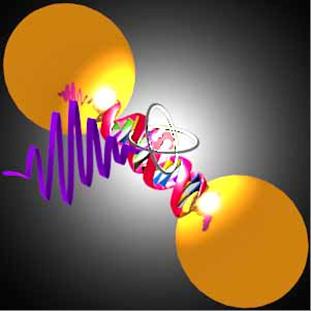Scientists from CNRS and Aix Marseille Université have successfully created a bio-inspired light called nanoantenna for the first time using two gold nanoparticles, short DNA strands and a tiny fluorescent molecule that is capable of capturing and emitting light.
 Schematic representation of a nanoantenna formed of two gold nanoparticles linked by a DNA double strand and supplied by a single quantum emitter. (© Busson, Rolly, Stout, Bonod, Bidault)
Schematic representation of a nanoantenna formed of two gold nanoparticles linked by a DNA double strand and supplied by a single quantum emitter. (© Busson, Rolly, Stout, Bonod, Bidault)
The researchers have reported their simple and user-friendly optical antenna in the Nature Communications journal. This work paves the way to develop highly efficient LEDs, ultra-compact solar cells and even finds use in quantum cryptography.
Similar to radio antennas that amplify radio waves of televisions and mobile phones, optical antennas can be used to amplify light signals because light is a wave. Nevertheless, nano-scale objects are required to confine light waves because of their ultrafast oscillation. Therefore, the optical counterpart of a basic antenna of dipole kind is a quantum emitter encircled by two nanoparticles.
The researchers embedded a fluorescent organic colorant, and 36-nm-diameter gold particles into short artificial DNA strands. The fluorescent molecule behaves like a quantum source, providing photons to the antenna, while interplay between the light and the emitter has been amplified by the gold nanoparticles. The researchers created several billion replicas of these particle pairs in solution in parallel through the control of the fluorescent molecule position with nanometric accuracy because of the DNA backbone.
These features outclass the potential of existing lithography techniques utilized in designing microprocessors. Such miniaturization opens the door to develop more compact solar cells, faster detectors, and high-efficiency LEDs, in the longer term. These nanosources of light hold potential in quantum cryptography.